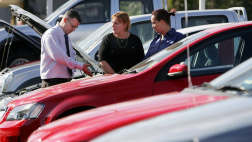Led by samples from some of China’s 480-plus EV manufacturers, the 2019 Shanghai motor show (April 16-25, 2019) showed the world exactly how it’s done, potentially drowning European and American EV manufacturers in a show of efficiency, style, quality and above all, affordability.
Unlike previous years there were few crazy, just plain wacky or often implausible excuses for transport shown. They’re serious.
Here’s a walk through some highlights, remembering the Shanghai show is huge, covering eight massive halls and painfully free of foot massage booths, McDonalds with beef (they use chicken) and real coffee.
Arcfox: BAIC Group’s high-end subsidiary, EV-maker Beijing New Energy Vehicle, unveiled three models of its new Arcfox line-up including this GT developed at its R&D centre in Spain.
It claims a 0-100km/h time of 2.59 seconds, an EV range of 600km and is ready for Level 3 autonomous certification.
BNEV made 158,000 EV cars last year but the first of its Arcfox models, an SUV, won’t be seen until next year.

Bosch: The IoT shuttle bus from Bosch is an autonomous inner-city and closed-route answer to mobility. It isn’t new - there are similar examples on trial in some Australian cities - but the big deal is that the shuttle reflects Bosch’s current autonomous vehicle projects with 40 Chinese car companies.
Enovate: The EV maker plans eight new models over the next five years from an EV factory now under construction.
Enovate’s parent company, DearCC, already makes small city EVs. The mid-size ME7 SUV is designed by the company’s design chief, Hakan Saracoglu who claims the Porsche 918 Spyder and the 911 GT2 RS as his designs.
The ME7 used the Shanghai motor show to collect orders and plans delivery later this year. It has 170kW/330Nm, a 500km range and runs 0-100km/h in 4.9 seconds.
FAW Bestune: The Bestune T77 is a model from the sub-brand of giant state-owned carmaker FAW Corporation.
The SUV is similar to rivals though boasts a multimedia system with a holographic assistant that can be customised between three different characters – a school girl, young boy and a robot - which each have five clothing options.
These assistants have 43 functions including making telephone calls, finding a radio station and controlling the radio volume, the wipers, air conditioning and sunroof.
GAC Changfeng: This company is owned by GAC Group but originated as a branch of the People’s Liberation Army.
The Leopaard (that’s how the company spells it) Mattu is an attractive SUV with a BMW-derived 147kW/270Nm 1.6-litre turbo-petrol engine. It is aimed at the premium sector.

Geometry: This is another Geely (owner of Volvo, Proton, Lotus, Lynk & Co) brand which shows its first model, the electric-only Geometry A sedan. It is a B-class car with a 500km range, Cd of only 0.237 and a single electric motor rated at 120kW/250Nm.
The A will be the first of a planned 10 new Geometry models released before 2025, including sedans, SUVs, crossovers and people movers based on platforms specific to Geometry models.

Grove: This new Chinese start-up claims to be the world’s first hydrogen fuel cell-only mass production company.
Its concept Grove Granite was designed by Pininfarina. Features include frameless doors and cameras that replace mirrors but no technical or performance details have been revealed.
Grove Hydrogen, part of a state-owned science institute, already makes and distributes hydrogen extracted from industrial waste and is expanding its infrastructure through China.
Grove has an agreement for distribution through an Australian company so could appear on our roads within a year or two.
Haval F7X: Haval has launched a coupe-styled SUV - yes, like the BMW X4 and Merc GLC - called the F7X that is going on sale in China.
There are no plans yet for Australia though it is based on the premium F7 (similar to the Australian-spec H6) that is ear-marked for Down Under.
The F7 (and F7X) gets a new 145kW/345Nm 2.0-litre turbo-petrol engine for 2019 replacing a 124kW/285Nm 1.5-litre unit.

Hongqi: This brand makes VIP limos for state officials but has moved into the high-end sports-sedan market.
The H5 Sport - based on Hongqi’s more conventional H5 sedan - was shown in Shanghai in unconventional non-government fleet yellow.
The H5 and Sport are based on a stretched Mazda6 platform. The Sport has a 132kW/250Nm 1.8-litre turbo-petrol engine and six-speed automatic transmission driving the front wheels.

Icona: The Icona design studio, responsible for the Vulcano titanium supercar concept, showed two weird and/or wonderful ideas on wheels.
The Nucleus was presented as an autonomous EV with an organic shape featuring “active opacity” windows (it’s a new trend, apparently) that are translucent body-colour panels allowing passengers to look out while preventing others from looking in.
The second vehicle is an autonomous logistics vehicle for Chinese online retail giant JD. It is planned as a “last-mile” delivery vehicle designed to transport goods between a delivery hub and the customer and has potential for production.
Jetour: If you wondered what happened to Chery, this is part of the story.
Jetour is a Chery sub-brand and picks up after Chery dumped its investment in another fresh Chinese carmaker, Qoros.
Jetour showed two of its models at the show - Jetour X70, which starts production in June, and X70S, which has been in production late last year.
It now plans 150,000 sales for 2019 and new models, including the Jetour X95 SUV, which is positioned above the X90, and its first BEV model, the X70S EV. People movers are planned for 2020.
Landwind: You may remember this name. It’s the first Chinese car company to get belted by a Beijing court for breach of copyright, ripping off the Range Rover Evoque with its X7 SUV.
The Changan subsidiary has now pulled its head in and made a big show of presenting its 2017-model X2 which - keeping up with form - resembles another existing vehicle, the Changan CS35.
The X2 is only the second product from Landwind after the forced axing the X7.

Leap Motor: This EV start-up has debuted a BEV with a 500km range and Level 3 autonomous capability and plans sales from the end of 2020.
It will follow its existing S01 EV that expects sales of 10,000 this year.

Lynk & Co: Volvo’s sister brand showed its 03 model, following the 01 and 02. This is the company’s first sedan (others are hatch and SUV) and shares its platform with the Volvo XC40 and upcoming S40 and V40.
The hybrid version is a plug-in with Volvo’s 1.5-litre three-cylinder engine and has a pure EV range of 65km. A full EV is also being developed. Funny name? It’s supposed to sound like lauded US brand Lincoln which has a lot of cred in China.

Maxus G20 FC: Maxus was expected to launch its first production fuel-cell EV here but the money was on an SUV.
Nup. This one’s a van that will come in executive transit format and meet the huge demand for such transport vehicles in China.
F20 FC is going into production in China this year and is likely for Australia.

Maxus V80 camper van: Recreational vehicles (RVs) aren’t big in China and touring the country's often spectacular regional centres isn’t high on the nation's list of leisure pursuits.
But Maxus (LDV in Australia) sees potential in a camper van for tourists in its home market and abroad and already has a strong following in NZ.
Australian distributor Ateco says its unlikely to import a fully built-up camper, preferring to import the base van and let Australian camper experts do the fit outs.

MG: Showed its MG6 (think Mazda6 with a 250kW 2.0-litre turbo-petrol engine and sequential gearbox) as the XPower TCR racer.
XPower was the race brand of the MG marque when it was in British ownership and under that name, won numerous events including land-speed records.
Now, the 2019 XPower TCR plans to be sold to privateers and compete in TCR (World Touring Car Championship) events throughout China and the rest of the world. It would compete with cars from 13 other manufacturers.

Nio: Public company Nio wants to be China’s answer to Tesla, listing on the New York stock market last year and raising $A1.3 billion (valuing it at about $A8 billion), and now showing its new Preview and concept Eve models at Shanghai.
It showed its first sedan, the ET Preview, at the show that now joins the ES6 and ES8 SUVs. The Preview is very similar in size to the Tesla Model S.
Ora: This is Great Wall Motor’s city EV. These tiny cars are an important cog in meeting company fleet emission rules and while seemingly perfect for congested roads, are rarely seen in cities like Shanghai.
Ora showed its cars amidst a stand of flowers and that message was either cleverly aimed environmentalists or florists needing a small delivery vehicle.
Qyev: New start-up electric sports carmaker showed one car - un-named - at the show and no details. Representatives on the stand said they were seeking investment opportunities to start production. Looks smart, though.








.jpg)


.jpg)






.jpg)
.jpg)
.jpg)
.jpg)






















.jpg)
.jpg)



.jpg)
Comments